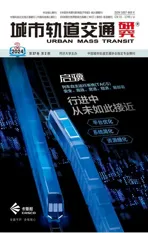我国城市轨道交通信号系统发展方向探讨
2024-02-22李中浩
李中浩
(中国城市轨道交通协会专家与学术委员会荣誉委员,正高级工程师)

中国的城市轨道交通信号系统具有后发优势,除了上世纪九十年代早期建设的几条地铁线路的信号系统外,几乎全部采用CBTC(基于通信的列车控制)系统,实现了移动闭塞,这是几代轨道交通信号人梦寐以求目标。随着北京燕房线自主化的基于CBTC的FAO(全自动运行)列车控制系统开通以后,多家国内信号供应商拥有了自主化的FAO产品,并得到了工程验证。中国城市轨道交通信号系统的发展进入了“无人(领跑)区”,我们必须自己回答,我国城市轨道交通信号系统向何处去。
谈到方向,就必须认清轨道交通有别于其他交通模式的特点。无论列车跑的多块,开的多密,有多少节车厢,轨道只有一条,这是唯一的专用资源,集中控制才能使唯一的专用资源在保证绝对安全的条件下发挥最大的效益,所以铁路具有半军事化的管理特征。铁路通过按图行车实现列车的集中调度指挥与控制,运行图是关联运输需求和运输能力的纽带。
FAO是城市轨道交通运输的发展方向,实现列车运行全过程的自动化,可以最大限度节省人力,提升运输效率,保证运输安全。FAO使信号系统的架构大大扩展了,凡是与列车运行安全、效率有关的专业,比如综合监控系统、供电系统、屏蔽门、旅客导向系统等,都可以归纳到FAO系统内。系统大了,出现故障的几率就大。考虑FAO系统的运行韧性,提升在故障环境下列车运行的效率,在故障条件下赋予列车自主运行的能力,成为发展中的需求。要实现这一目标,需要引入“故障导向安全运行”的理念。信号系统最显著的特点是“故障导向安全”,这是指在任何情况下要保证列车运行的绝对安全。当采用FAO系统以后,故障导向安全的安全侧发生了变化,安全侧要求保证乘客的绝对安全,而不仅仅是保证列车装备的绝对安全。引入故障导向安全运行的原则要求具有列车自主运行功能的FAO系统,要求具有有安全完整性要求的列车主动障碍物检知的功能。
具有列车自主运行功能的FAO系统,是对FAO系统提出的特殊要求。需要强调:一是在FAO系统正常时,系统处于全自动运行状态,不需要赋予列车自主运行的能力;二是市域快轨等中小运量系统,不必都采用具有列车自主运行功能的FAO系统。
运行图指令的下达,传统的路径是下达给地面装备,由地面装备对轨道唯一资源进行联锁,形成列车安全运行的进路后,通知列车在指定范围内按给定的速度行车。为了提高地面资源的利用率,也有将运行图指令下达给列车,由列车向地面要资源,地面资源可以缩小联锁单元,结合车车通信等新的联锁条件,提高资源利用率、提升运输效率。有些信号供应商把车车通信也看作一种信号制式,这是不对的,车车通信只是一种技术手段。
地铁是以通勤流为主的大运量交通运输工具,早晚高峰特征非常明显,从缩短运行间隔、减少能耗的角度,针对这种运输模式,灵活编组是刚需;如果能实现动态灵活编组将更有利于运输组织。有一种动态灵活编组的形式是虚拟联挂。技术上实现虚拟联挂,一定要对列车的加速度进行控制,对列车的速度控制也更为精确,这样才能具有撞软墙功能;但是将虚拟联挂用于运输组织并且确保安全和带来效益,还需要工程验证。
我国城市轨道交通信号系统的发展进入无人区以后,信号系统的标准化显得更为重要。为此,中国城市轨道交通协会组织编制了CMTCS(中国城市轨道交通列车运行控制系统)总则,归纳了城市轨道交通信号系统的本质需求,将其分为CMTCS0—CMTCS4五个种类。CMTCS0具有ATP(列车自动保护)功能,CMTCS1具有ATO(列车自动运行)功能,CMTCS2具有FAO功能,CMTCS3具有故障条件下列车自主运行功能,CMTCS4具有动态灵活编组功能。将互联互通的需求作为CBTC系统的基本需求。各个级别之间没有谁比谁更先进一说,只有谁比谁更适用的选择。
在城市轨道交通进入网络化的时代,我国的轨道交通建设正在从高速发展阶段转向高质量建设阶段,其经济性、可持续发展的要求尤其要引起重视。所有的运输装备要以满足运输需求为目的,要满足交通强国提出的安全、高效、便捷、绿色、经济的总体方针要求,这才是中国城市轨道交通信号系统的发展方向。
Commentary
Discussion on the Development Direction of Urban Rail Transit Signaling Systems in China
LIZhonghao
(Honorary Committee Member of China Association of Metros Expert and Academic Committee,Professor-level Senior Engineer)
China′s urban rail transit signaling systems possess the distinct advantage of later development.Nearly all existing metro lines adopt CBTC (communication-based train control) system and has achieved moving block except for few lines constructed in early 1990s,which is a long-awaited goal for several generations of rail transit signal professionals.Following the commissioning of Beijing Subway Yanfang Line FAO (fully automatic operation) train control system based on CBTC,numerous Chinese signaling system suppliers have independently developed their FAO products and completed engineering validation.The development of China urban rail transit signaling systems is now entering the ′unmanned (leadership)′ phase.The question of the future direction for China urban rail transit signaling systems must be addressed by ourselves independently.
When it comes to direction,it is essential to recognize the characteristics that set rail transit apart from other transportation modes.Regardless of the train speed level,departure density,or the number of compartments,there is only one track,making it the sole dedicated resource.Only centralized control can ensure that this sole dedicated resource operates at maximum efficiency while maintaining absolute safety.Consequently,railway inherits a semi-militarized management characteristic.Railway achieves centralized dispatching,command,and control of trains by adhering to train diagram,which serves as the link between transportation demand and transport capacity.
FAO (fully automatic operation) is the development direction for urban rail transit transportation.By implementing the automation of train operation entire process,manpower can be significantly saved,transportation efficiency enhanced,and transportation safety ensured.FAO greatly expands the architecture of the signaling system.Any disciplines related to train operation safety and efficiency,such as comprehensive monitoring systems,power supply systems,platform screen doors,and passenger guidance systems,can be categorized under FAO system.With a larger system,the probability of malfunctions increases.Considering the operational resilience of the FAO system and improving the efficiency of train operation under fault conditions,the ability to enable trains to operate autonomously in fault conditions becomes a developmental requirement.To achieve this goal,it is necessary to introduce the concept of ′fault-tolerant safe operation.′ The most significant feature of signaling system is ′fault-tolerant safety,′ which means ensuring the absolute safety of train operation under any circumstances.When adopting FAO system,the aspect of fault-tolerant safety changes to demanding the absolute safety of passengers,in addition to the absolute safety of train equipment.The introduction of fault-tolerant safe operation principles requires FAO systems with train autonomous operation capabilities to have active obstacle detection functions that meet safety integrity requirements.
FAO systems with train autonomous operation capabilities impose specific requirements on FAO system.It is essential to emphasize that:first,when the FAO system is functioning normally,it operates in fully automatic mode,without the necessity to grant train the autonomous operation capability; secondly,for low-medium capacity systems such as urban rapid rail,it is not necessary for all of them to adopt FAO systems with train autonomous operation capabilities.
The issuance of train diagram instructions conventionally involves communicating through pathway to ground equipment.The ground equipment then interlocks the sole dedicated track resource to establish a train safe operation entry routing,notifying the train to travel within a specified range at a given speed.In order to improve ground resource utilization rates,there is also the approach of issuing train diagram instructions directly to trains,letting trains request resources from the ground,and the ground resource can reduce interlocking units.Considering new interlocking conditions such as train-to-train communication,resource utilization rate can be improved,leading to enhanced transport efficiency.Some signaling suppliers incorrectly consider train-to-train communication as a signaling system,whereas it is simply a technical means.
Metro is the high-capacity transportation means primarily serving commuting flows,and the characteristics of peak hours are very prominent.From the perspective of shortening the operating intervals and reducing energy consumption,flexible train formation is essential for this transportation mode,and achieving dynamic flexible marshalling is advantageous for transport organization,a specific form of which is virtual coupling.Technically,implementing virtual coupling requires controlling the acceleration of trains and ensuring precise speed control to have crash-softening capabilities.However,engineering validation is needed for applying virtual coupling to transport organization,ensuring safety,and delivering benefits.
After the development of urban rail transit signaling systems in China has entered the era of unmanned operation,standardization of signaling systems becomes evidently crucial.In response,the China Association of Metros organizes the compilation of the CMTCS (China Metro Train Control System) general principles.These principles summarize the essential requirements of urban rail transit signaling systems,categorizing them into five types:CMTCS0 to CMTCS4.CMTCS0 has ATP (automatic train protection) functionality,CMTCS1 has ATO (automatic train operation) functionality,CMTCS2 has FAO functionality,CMTCS3 has train autonomous operation functionality under fault conditions,and CMTCS4 has dynamic flexible marshalling functionality.The demand for interoperability is considered a fundamental requirement of the CBTC system.There is no claim that one level is more advanced than another; instead,the focus is on applying the most suitable version.
As urban rail transit enters the era of networking,China′s rail transit construction is transitioning from a high-speed development stage to a high-quality construction stage.The economic and sustainable development requirements are especially emphasized.All transportation equipment must aim to meet transportation needs and fulfill the overall policy requirements of being safe,efficient,convenient,green,and economical,as outlined in the strategy for building a nation of transportation power.The development direction for China′s urban rail transit signaling systems is thus established.
(TranslatedbyZHANGLiman)
